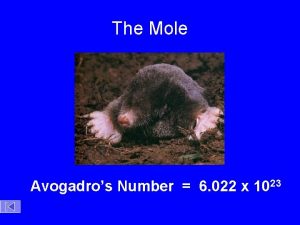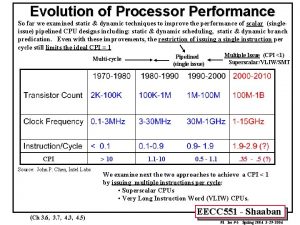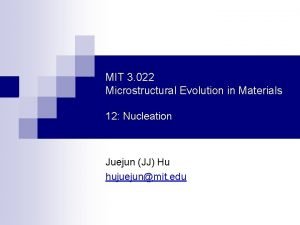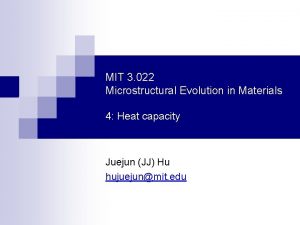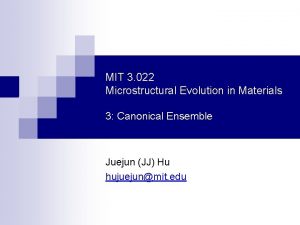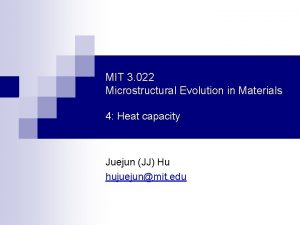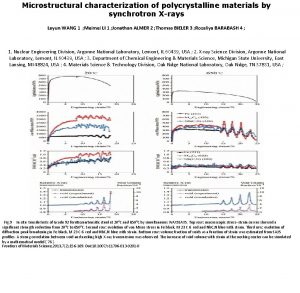MIT 3 022 Microstructural Evolution in Materials 12























- Slides: 23

MIT 3. 022 Microstructural Evolution in Materials 12: Nucleation Juejun (JJ) Hu hujuejun@mit. edu

Thermodynamics of phase transition G H Liquid Supercooled liquid Liquid Crystal Tm T

Homogeneous nucleation from a fluid phase Liquid Crystal nucleus r Volumetric Surface

Thermodynamics of homogeneous nucleation G Liquid n Volumetric Gibbs free energy change n Surface energy change Crystal T Tm

Gibbs free energy change in solidification Nucleus size r n Gibbs free energy change of nucleation n Critical nucleus size n Energy barrier towards nucleation

Vapor-liquid nucleation of water

“Seeing” nucleation using atomic tomography https: //www. nature. com/articles/s 41586 -019 -1317 -x

Density of critical nuclei n Number of clusters with size greater than r where n Example: number of ice clusters in 1 g of water at 0 °C g = 0. 033 J/m 2, DHm = 333. 6 J/g, Tm = 273. 15 K ¨ r > 0. 4 nm (~ 9 molecules): 1. 3 × 1015 ¨ r > 0. 7 nm (~ 48 molecules): 0. 7 A supercooling threshold exists for onset of nucleation events

Homogeneous nucleation rate n Nucleation rate I = Number of nuclei with size just under r* × Rate of atoms hopping to the nuclei I Nucleation onset DT 0 Driving force limited Diffusion limited

Experimental measurement of nucleation rate Liquid Nucleation Growth Nucleation rate in lithium silicate glass Nucleation zone T Tm Nucleation zone t Adapted from Phys. Chem. Glasses 15, 95 (1974)

Heterogeneous nucleation n Gibbs free energy change of cluster formation ¨ Liquid Cluster Volumetric term Substrate ¨ Surface term Y-L equation:

Heterogeneous nucleation n Gibbs free energy change of cluster formation ¨ Volumetric term ¨ Surface term

n Critical nucleus size n Energy barrier towards nucleation Wetting on a substrate reduces energy barrier towards nucleation Gibbs free energy change Heterogeneous nucleation Nucleus size r

Nucleation kinetics and grain size Magnesium alloy w/o Si. C particles Magnesium alloy with Si. C particles Fast cooling and addition of secondary phase contribute to grain refinement Acta Mater. 54, 5591 (2006)

Vapor-Liquid-Solid (VLS) nanowire growth Interface where growth continues Si. Cl 4 vapor + H 2 Melted gold nanoparticles saturated with Si. H 4 Growth direction Substrate Heterogeneous nucleation of Si at the interface Temperature for Si deposition on a planar substrate (homogeneous nucleation): ~ 800 ˚C Substrate Diameter of nanowire is determined by the gold droplet size

Nanowires formed by VLS growth Gold nanoparticle Growth direction S. Kodambaka, J. Tersoff, M. C. Reuter, and F. M. Ross, Science 316, 729 (2007).

Why gold? Reason #1: Low eutectic temperature Question: what would happen if we were to grow nanowires at high temperature? “The influence of the surface migration of gold on the growth of silicon nanowires, ” Nature 440, 69 -71 (2006).

Why gold? Reason #2: Small gold solubility in Si (Eutectoid transformation) Question: why is such small solubility important? 99. 8% Solubility: 0. 2% Albert P. Levitt, Whisker Technology (1975)

Summary n n Driving force for nucleation ¨ Supercooling (undercooling) ¨ Volumetric Gibbs free energy reduction Energy barrier against nucleation ¨ n n Surface energy Kinetics of nucleation ¨ Number of sub-critical nuclei ¨ Diffusion Heterogeneous nucleation ¨ Lowering the surface energy barrier of nucleation

List of symbols n T – temperature n k – Boltzmann constant (1. 38 × 10 -23 m 2 kg s-2 K-1) n GL / HL / SL – Gibbs free energy / enthalpy / entropy of liquid n GC / HC / SC – Gibbs free energy / enthalpy / entropy of crystalline solid n Tm – melting point n DG – Gibbs free energy change associated with phase transition n DGV / DGS – volumetric / surface contributions to Gibbs free energy change of phase transition n r – radius of nucleus

List of symbols n DHm – enthalpy of fusion per unit volume n V – volume of nucleus n DT – supercooling, defined as: n g – surface/interface energy n S – surface area of nucleus n r* – critical nucleus size n DG* – energy barrier towards nucleation n nr – number of clusters with size greater than r n n 0 – number of atoms/molecules in the system (see discussions at the notes section of slide 7) n I – nucleation rate

List of symbols n nh – frequency of successful atomic hops from liquid phase to the nucleus n n – vibrational frequency of atoms in the liquid phase n D – diffusion coefficient (from liquid phase to the nucleus) n a – atomic hopping distance n VC – volume of cluster (which serves as a nucleus in heterogenous nucleation process) n g. SL / g. SC / g. LC – interface energy between S: substrate, C: cluster, and L: liquid phase n n q – contact angle – defined as:

List of symbols n DGhet / DGhomo – Gibbs free energy change associated with heterogeneous / homogeneous nucleation n – critical nucleus size in heterogeneous / homogeneous nucleation n – energy barrier towards heterogeneous nucleation
 6 022 x 10^23
6 022 x 10^23 Artigo 022
Artigo 022 Tel 022
Tel 022 Adopting materials
Adopting materials Cant stop the feeling trolls go noodle
Cant stop the feeling trolls go noodle Direct materials budget with multiple materials
Direct materials budget with multiple materials Useful household materials
Useful household materials Man made materials
Man made materials Kpcofgs mnemonic device
Kpcofgs mnemonic device Frise chronologique robotique
Frise chronologique robotique 17-4 patterns of evolution
17-4 patterns of evolution Darwin and evolution
Darwin and evolution Evolution
Evolution Evolution of processor
Evolution of processor Historical development of community health nursing
Historical development of community health nursing Why are populations the smallest unit of evolution
Why are populations the smallest unit of evolution Genetics
Genetics Invertebrate evolution and diversity 2
Invertebrate evolution and diversity 2 Evolution of indian financial system
Evolution of indian financial system Embryology evidence
Embryology evidence Convergent evolution
Convergent evolution Picture of natural selection
Picture of natural selection Evolution of management theory
Evolution of management theory Evolution: the beginning
Evolution: the beginning
